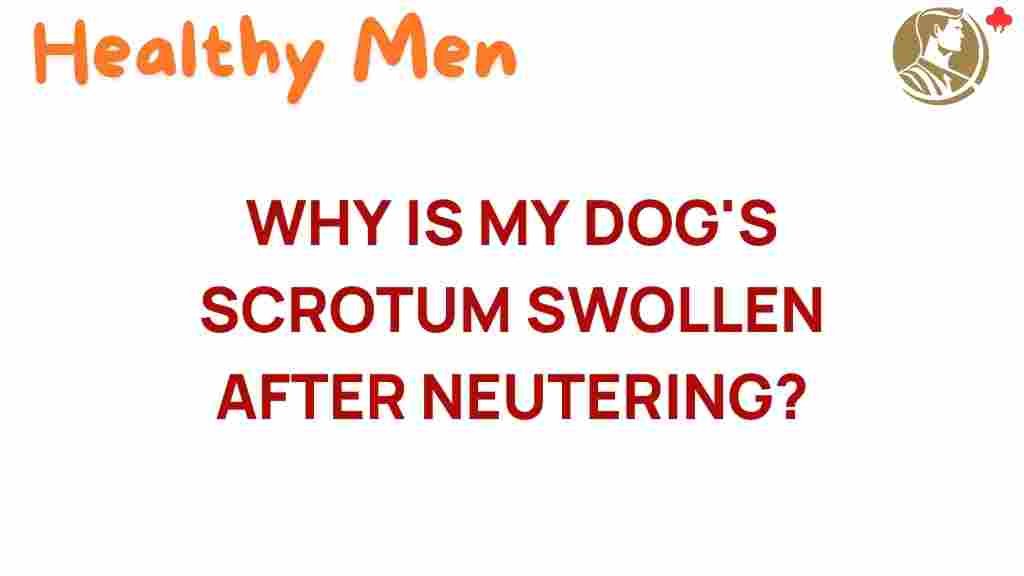Unraveling the Mystery: Why Is My Dog’s Scrotum Swollen After Neutering?
Neutering is a common procedure that many pet owners choose for their dogs, often to prevent unwanted litters and reduce certain behavioral issues. However, it’s not uncommon for pet owners to notice some swelling in their dog’s scrotum after the surgery. This article aims to shed light on the reasons behind this phenomenon, focusing on dog health, neutering, scrotum swelling, post-surgery care, and canine recovery. If you’ve recently had your dog neutered and are concerned about scrotum swelling, this comprehensive guide will provide you with the information you need.
Understanding Neutering and Its Effects
Neutering, or castration, involves the surgical removal of a male dog’s testicles. This procedure not only prevents reproduction but can also contribute to improved behavior and can help reduce the risk of certain health issues. However, it’s essential to understand that neutering is a surgical procedure and, like any surgery, it comes with potential side effects.
What Causes Scrotum Swelling After Neutering?
Scrotum swelling after neutering can be disconcerting for pet owners. Here are some common reasons for this swelling:
- Normal Post-Surgical Swelling: It is normal for the surgical site to experience some swelling as part of the healing process. This swelling typically resolves within a few days.
- Fluid Accumulation: Sometimes, fluid can accumulate in the scrotal area, leading to a condition known as a seroma. This usually occurs due to the surgical trauma and is often harmless.
- Infection: Although rare, an infection can cause swelling and may require veterinary attention. Signs of infection include redness, heat, and discharge.
- Allergic Reaction: Occasionally, dogs may have an allergic reaction to the sutures or medications used during the procedure, which can lead to localized swelling.
Post-Surgery Care and Monitoring Your Dog’s Recovery
Proper post-surgery care is crucial for your dog’s recovery. Here are some essential tips to ensure your dog’s health and comfort during the recovery period:
1. Follow Veterinary Instructions
Always adhere to the specific post-operative instructions provided by your veterinarian. This may include:
- Medication schedules.
- Activity restrictions.
- How to care for the surgical site.
2. Monitor the Surgical Site
Keep an eye on the surgical site for any signs of swelling, redness, or discharge. If you notice excessive swelling or any other concerning symptoms, do not hesitate to contact your veterinarian.
3. Restrict Activity
Limit your dog’s physical activity for at least 7-10 days post-surgery. This includes avoiding running, jumping, and playing with other pets. A calm environment will help your dog heal more quickly.
4. Use an Elizabethan Collar
Consider using an Elizabethan collar (cone) to prevent your dog from licking or biting at the surgical site, which can lead to complications.
5. Provide Comfort
Make your dog comfortable by providing a quiet, cozy space to rest. Ensure they have access to fresh water and their favorite toys.
Troubleshooting: When to Seek Veterinary Advice
While some swelling is normal, it’s essential to be vigilant about your dog’s recovery. Here are some signs that warrant a call to your veterinarian:
- Swelling that worsens instead of improving after a few days.
- Redness or heat around the surgical site.
- Discharge that is foul-smelling or excessive.
- Signs of pain such as whining, excessive licking at the site, or reluctance to move.
- Loss of appetite or lethargy.
If you notice any of these symptoms, it’s crucial to contact your veterinarian for advice. Early intervention can prevent more serious complications.
Why Is Veterinary Advice Important?
Veterinary advice is essential for ensuring your dog’s health and safety during recovery. Your veterinarian can provide insight into what is typical and what is not, helping you navigate any concerns you may have about your dog’s post-surgery condition. Regular check-ups and open communication with your vet can help you stay informed about your dog’s health after neutering.
Conclusion
In summary, while scrotum swelling after neutering can be concerning, understanding the normal healing process can alleviate some of that worry. Remember that some swelling is typical and usually resolves on its own within a few days. Proper post-surgery care, monitoring, and adherence to veterinary advice are crucial for your dog’s recovery.
If you ever feel unsure or worried about your dog’s condition, do not hesitate to reach out to your veterinarian. They are your best resource for ensuring your dog’s health and well-being during this time. For more information on canine recovery and post-surgery care, visit this helpful resource.
Taking these steps will help ensure a smooth recovery for your dog, allowing them to return to their happy, active selves in no time. Remember, your dog’s health is paramount, and being proactive in their care will make all the difference.
This article is in the category Conditions and created by healthymen Team
